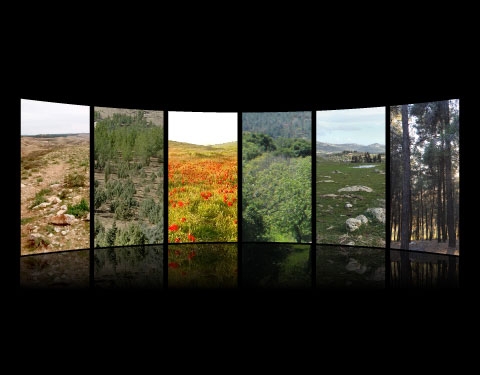Location & Background | Project Overview | Graphs & Data
Water and carbon are strategic commodities. Rapidly growing population and a trend toward urbanization as well as predicted climatic changes will heighten water shortages and open land available for forestation and carbon storage. An alarming turn in this respect comes from the IPCC 2007 report predicting ~20% decrease in precipitation in the Mediterranean basin region, associated with warming of 2-4˚C by the end of the century.
In the Yatir Project, initiated in 2000, we focus specifically on the complex impact of land use changes, such as afforestation, on carbon sequestration potential, surface temperature (energy budget), and water yield (the difference between precipitation and loss by evapotranspiration). Understanding these aspects and the unavoidable tradeoffs among them are often neglected, especially in the semi-arid region. But their knowledge should be used as a critical tool in formulating national and regional water and carbon management policies. Quantitative knowledge of these tradeoffs should also help in better understanding biosphere-atmosphere interactions on the global scale.
 The importance of land cover, and forestation in particular, on water yield has been noted in the past: Stanhil estimated in 1993 that land use changes in Israel, from extensive tree cover (e.g. 10,000 years ago) to intensive agriculture (today) significantly altered water yield. A main consequence of widespread decrease in evapotranspiration due to land use changes, or due to high CO2 induced reduction in plant transpiration, is increase in runoff, contributing to floods, erosion and loss of fertile soils.
The importance of land cover, and forestation in particular, on water yield has been noted in the past: Stanhil estimated in 1993 that land use changes in Israel, from extensive tree cover (e.g. 10,000 years ago) to intensive agriculture (today) significantly altered water yield. A main consequence of widespread decrease in evapotranspiration due to land use changes, or due to high CO2 induced reduction in plant transpiration, is increase in runoff, contributing to floods, erosion and loss of fertile soils.
Evapotranspiration, however, also provides the driving force for forest growth and carbon sequestration (together with other factors, such as nutrient availability). Using the Yatir forest as a case study, we have demonstrated that the semi-arid zone has, in fact, greater potential than initially expected for carbon sequestration, the consequently in the development of productive pine forests. In addition to the obvious tradeoffs between water yield and carbon sequestration, afforestation in the semi-arid region also has larger than expected effects on surface temperatures.
 This is because of the prevalent high solar radiation and low cloud cover, and the large changes in surface albedo (reflectivity) associated with forestation of local bare and bright surfaces.
This is because of the prevalent high solar radiation and low cloud cover, and the large changes in surface albedo (reflectivity) associated with forestation of local bare and bright surfaces.
On sufficiently large scales, such changes in surface energy budget can influence local climate. Changes in forest cover due to climate change or human activities, have therefore complex but important consequences for water, carbon and the local environment that are poorly understood at present. Such changes could feed-back on the atmosphere and climate system. We are at a good position in terms of location and scientific expertise to significantly advance our knowledge on this front.
Current Projects
- Extrapolation of meteorological parameters along the climatic gradient in Israel
- Surface energy balance along the climatic gradient in Israel
- Eliminating summer droughts by irrigation experiment in the semi arid forest
- Resilience to seasonal heat wave episodes in a Mediterranean pine forest
- The climatic effects of large-scale afforestation in semi-arid regions around the world
- Developing the use of carbonyl sulfide (COS) to constrain gross photosynthesis (GPP)
- Partitioning soil CO2 flux in a semi-arid Mediterranean environments
- Evapotranspiration components and their differential effects on water use efficiency
- Estimation GPP in a semi-arid forest and its links to climate and physiology
- Numerical modeling of evapotranspiration in the Yatir Forest ecosystem
- Hydrological Dynamics of near-surface atmospheric water vapor exchange
- Ecophysiological responses to drought in a Mediterranean pine forests




